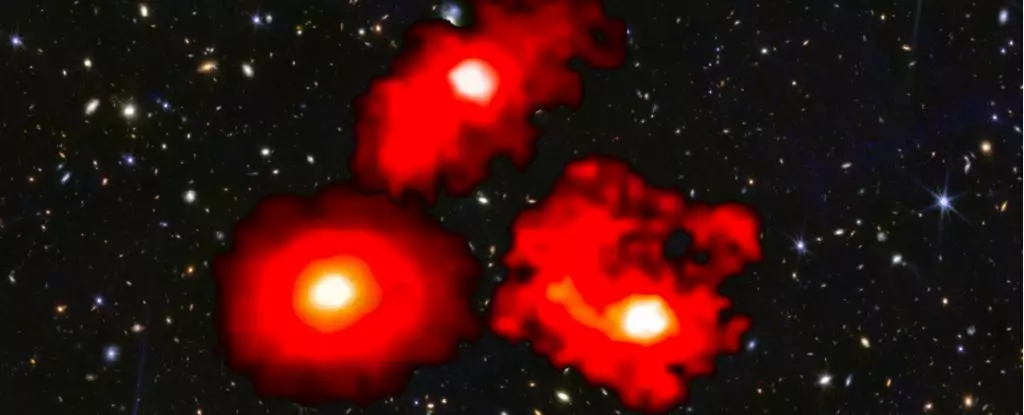In a groundbreaking revelation, astronomers have unearthed what they dub ‘red monsters’—three massive galaxies dating back to the Cosmic Dawn, an era shortly after the Big Bang. These galaxies are astonishingly comparable in size to our Milky Way, yet their existence raises significant questions regarding current astrophysical models and theories of galaxy formation. This unexpected discovery highlights the inherent complexities surrounding the evolution of the Universe and invites us to rethink our foundational assumptions about cosmic structures during their infancy.
The detection of these large galaxies so soon after the Universe’s inception perplexes scientists. Ivo Labbé, an astronomer from Swinburne University of Technology, likens this phenomenon to the absurdity of spotting a 100-kilogram toddler. Astronomical findings derived from the James Webb Space Telescope (JWST) have turned conventional wisdom on its head. Traditionally, we understood that galaxies take time to assemble, influenced primarily by dark matter and baryonic matter interactions. However, the sheer size of these galaxies challenges our timeline of cosmic development.
Astrophysical models generally posit a gradually evolving Universe, where stardust coalesces over time, leading to the formation of massive galaxies. Yet the newly observed ‘red monsters’ emerged within the first billion years post-Big Bang, an era known as the Cosmic Dawn. If these galaxies could form as rapidly as reported, then our understanding of galactic evolution may need substantial revision.
The James Webb Space Telescope has revolutionized our ability to peer into the farthest reaches of the Universe. By detecting infrared wavelengths, JWST offers insights into structures previously cloaked by cosmic distances. With this new tool, astronomers are beginning to bridge gaps in our knowledge of the Universe’s early years. The swift formation of massive galaxies like the ‘red monsters’ indicates that the processes defining galactic evolution are far more dynamic than previously believed.
There is an ongoing debate about the validity of current models pertaining to star formation rates and galaxy assembly. While conventional models suggest slow growth, JWST’s observations indicate that the baryonic material converted into stars can occur at rates significantly higher than anticipated. The implications of these findings compel us to reconsider the mechanisms at play in the formation of such large cosmic entities so early in our Universe’s history.
The journals of astrobiology are rife with hypotheses attempting to explain these extraordinary galaxies. One theory posits that the enormous size of these galaxies may be an optical illusion rooted in possibly overwhelming luminosity from black holes at their centers. High-intensity emissions might skew our perception of size, suggesting these galaxies might not be as large as they appear. Moreover, some observations indicate that supermassive black holes can momentarily brighten galaxies, lending credence to this theory.
Nevertheless, recent studies spearheaded by astronomer Mengyuan Xiao and his team challenge this narrative. The research reveals that, in at least some instances, these ‘red monsters’ genuinely are massive and validate their verifiable sizes through direct measurements. Such an assertion implies that the traditional belief that the Universe could not support such size early on may require fundamental reassessment.
A critical challenge posed by these findings pertains to our understanding of star formation rates within galaxies. Typically, active galaxies exhibit feedback mechanisms limiting the formation of new stars. Exceedingly high feedback could theoretically suppress star development, yet the ‘red monsters’ exhibit signs of a vigorous stellar ecosystem wherein new stars are being born at astonishingly high rates—two to three times faster than previously recorded.
This formidable star formation activity contradicts the existing models and suggests a much more efficient process unfolding within these nascent galaxies. As Labbé suggests, the current frameworks for understanding star formation in the early Universe seem inadequate, leaving astronomers grappling for explanations as to why these galaxies’ growth trajectories defy expectations.
The discovery of the ‘red monsters’ has opened a crucial dialogue regarding galaxy formation and star development during the early Universe. As JWST continues to unravel the secrets of the Cosmic Dawn, it becomes increasingly evident that our comprehension of cosmic evolution might need a profound overhaul. As our observational technology and methodologies evolve, the quest to understand these enigmatic galaxies will remain at the forefront of astrophysical research. The fundamental reexamination of our models serves as a reminder that the cosmos continually has surprises in store, urging us to remain adaptable in the face of new evidence.

